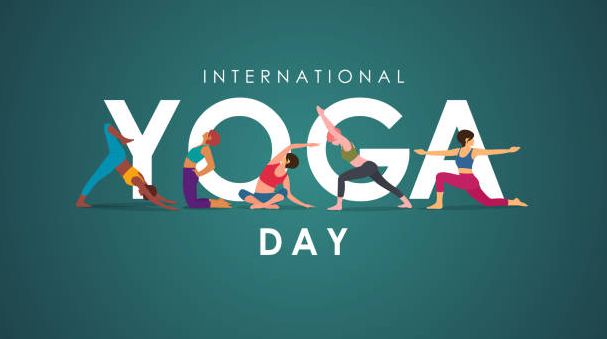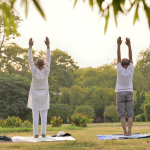INTERNATIONAL YOGA DAY
Yoga is not just a physical exercise or a cultural tradition—it is a deep, sacred science of living that was gifted to the world thousands of years ago by the ancient Indian sages. The celebration of International Yoga Day on June 21 is not a trend or a formality; it is a recognition of yoga as one of humanity’s most powerful tools for healing, self-realization, and balance in a world that is suffering from spiritual hunger, emotional chaos, and physical restlessness.
The purpose of celebrating Yoga Day is to awaken human beings to their true potential by bringing back harmony between body, breath, mind, and spirit. It reminds us that peace does not come from the outside, but from the stillness within, and yoga is the bridge to that stillness. The date June 21, the summer solstice and the longest day of the year in the northern hemisphere, was chosen not randomly, but spiritually—because it marks a powerful point of transformation and cosmic energy, and according to ancient wisdom, it is the day Lord Shiva, the Adiyogi, began sharing yoga with humanity.
In this modern age where mental illnesses, heart problems, lifestyle diseases, and emotional breakdowns have become common, yoga offers not only physical health but deep psychological and emotional healing, without any side effects or artificial chemicals. Yoga is a complete science that connects the muscles with the breath, the heart with the mind, and the soul with the universe. Its benefits are not limited to flexibility or fitness—it transforms the human being from inside out.
Regular yoga practice has been proven through scientific research to reduce stress hormones like cortisol, improve brain function, increase concentration and memory, and boost immunity. The breathing techniques in yoga, like Anulom Vilom, Bhramari, and Kapalbhati, cleanse the respiratory system, regulate blood pressure, increase oxygen flow to the brain, and balance the nervous system.
Physical postures like Tadasana, Bhujangasana, Vajrasana, and Surya Namaskar stretch and strengthen every muscle and organ, improve posture, digestion, and hormonal health, and release stiffness from joints. The meditative practices calm the mind, reduce anxiety, fight depression, and awaken inner awareness. Even five to ten minutes of daily yoga can positively impact mood, energy, focus, and sleep quality.
Yoga has shown miraculous results in managing chronic conditions like arthritis, asthma, diabetes, thyroid imbalance, migraine, and spinal problems, without invasive treatment. Nowadays in India, more and more people who are suffering from depression, anxiety, emotional trauma, and chronic stress are turning to yoga centres—and there is a very deep and powerful reason behind this growing trend.
Modern life has become a constant race filled with competition, social pressure, relationship breakdowns, job insecurity, and endless digital distractions. While people may appear to smile on the outside, inside many are silently battling loneliness, guilt, fear, and a sense of emptiness. Medicines may help temporarily, but they often come with side effects and do not heal the deeper emotional wounds.
When sleepless nights become normal, when overthinking drains energy, and when life starts to lose its meaning, yoga becomes a light in the darkness. Yoga therapy centres help people regulate their breath, reset their nervous system, and reconnect with their inner calm. Techniques like meditation, mindfulness, deep breathing, and slow movement postures activate the parasympathetic nervous system—the healing system of the body. It reduces the racing thoughts, calms the panic inside the chest, and teaches people to live in the now, rather than being trapped in past regrets or future worries.
Many counsellors and psychologists now recommend yoga as a companion treatment for depression, because it not only changes brain chemistry naturally but also gives people a sense of control, purpose, and healing from within. But yoga is not just about health—it is about living life with purpose, peace, and presence.
The real meaning of the word ‘Yoga’ comes from the Sanskrit root ‘Yuj’ which means ‘to unite.’ Yoga unites us with our breath, with the moment, with our inner conscience, and ultimately with the Divine. It teaches us to observe our thoughts, to slow down, to live mindfully, and to overcome the noise of the outside world.
In this age of constant distractions, where people are lost in screens, competition, and consumerism, yoga brings us back to simplicity, silence, and self-control. It trains us not only to move our bodies but to discipline our desires, to control anger, ego, and fear, and to awaken compassion, patience, and gratitude. It teaches values like ahimsa (non-violence), satya (truth), brahmacharya (self-restraint), and santosh (contentment), which are not just moral rules but keys to emotional freedom and spiritual evolution.
Yoga is not bound by religion, caste, language, or age. Whether you are young or old, rich or poor, Indian or foreigner—your body, breath, and heart are the same. Yoga speaks to the universal nature within us.
The different branches of yoga offer different paths based on personality and purpose. Hatha yoga focuses on physical balance and posture. Raja yoga focuses on mental mastery and meditation. Bhakti yoga is the path of devotion and love. Karma yoga is the path of selfless service. Jnana yoga is the path of wisdom and self-inquiry. Each of these helps in transforming human nature towards higher consciousness.
The practice of yoga doesn’t demand hours of effort or expensive equipment—it only needs sincerity and consistency. Even doing Surya Namaskar daily, followed by some pranayama and silent meditation, can deeply reset the nervous system and cleanse negative energies stored in the body. Children who practice yoga from a young age develop stronger focus, better discipline, emotional maturity, and physical immunity.
Elderly people find relief from pain, anxiety, and sleep issues. Pregnant women can use yoga to ease delivery, reduce swelling, and increase emotional calm. Office workers suffering from stress, neck pain, and digital fatigue can find daily relief through mindful stretches and breathing breaks. Yoga benefits everyone—students, parents, workers, leaders—and connects humanity through a shared language of stillness and breath.
Celebrating Yoga Day is not about organizing big events or showing off difficult poses—it is about making a commitment to return to the natural wisdom of the body and mind. It is a reminder to all nations that beyond medicine and machines, lies a deeper cure inside us—our breath. This celebration is a global call to reconnect with our roots, our planet, and our real priorities. It teaches us to pause and listen—to our heartbeats, to our pain, to our need for meaning.
As the world faces climate crisis, war, violence, and depression, yoga can offer a path of healing not only for the individual but for collective human consciousness. It brings balance between the inner and outer world. It helps us love more, judge less, speak kindly, live slowly, and think deeply.
Let this Yoga Day not be a one-day event but the start of a new lifestyle. Even in the busiest schedule, give at least ten minutes to your breath, to your body, and to your soul. Learn from nature, align your spine, inhale truth, and exhale fear.
Let yoga not remain a subject of posters and speeches but become a living, breathing prayer of your daily life. The world needs more peace than power, more silence than sound, more healing than hurry—and yoga is the key that unlocks it all.







